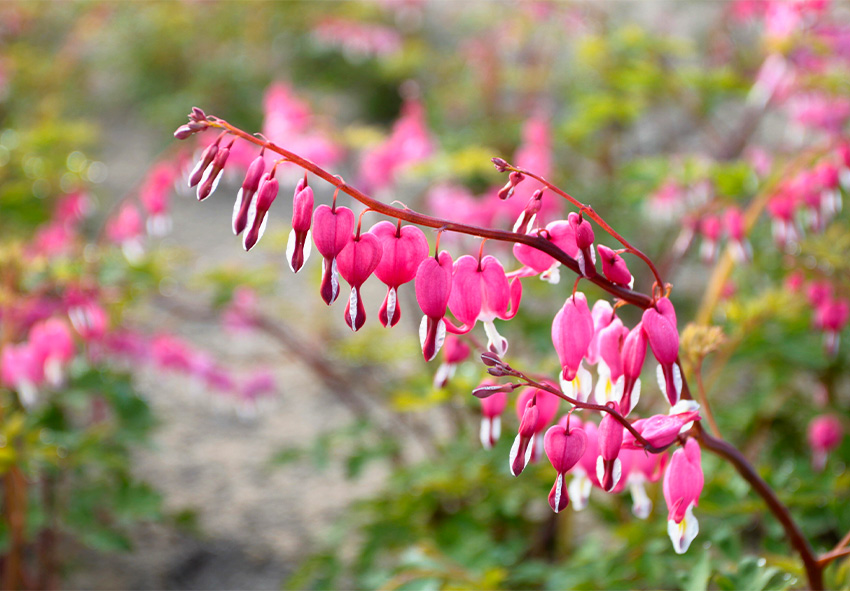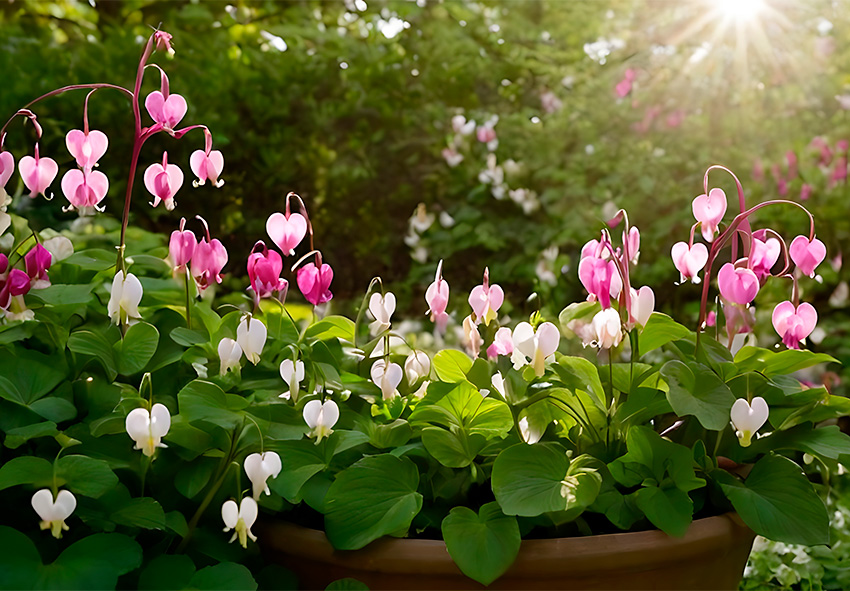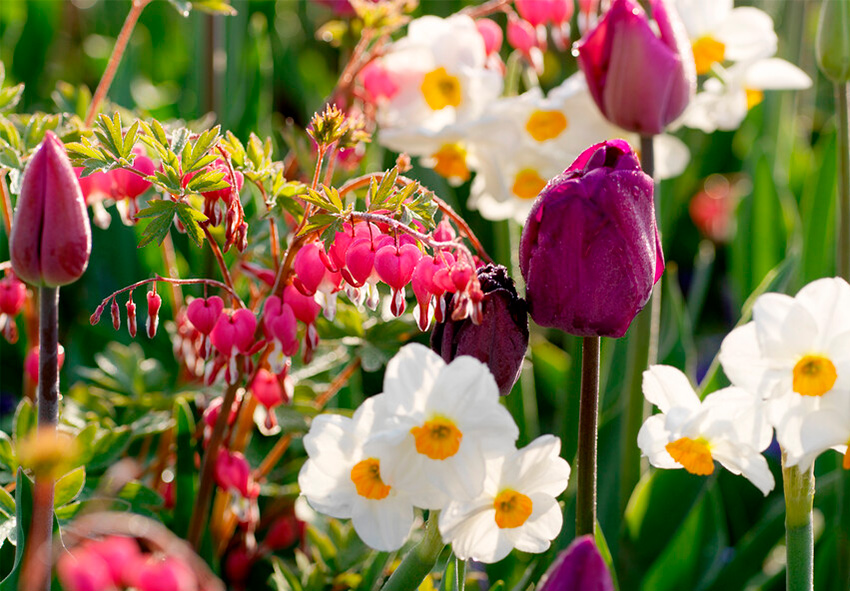Dicentra, commonly known as Bleeding Heart, is a graceful and charming addition to any garden, known for its heart-shaped flowers and delicate foliage. Its soft, romantic appearance makes it a favorite for creating cottage-style gardens or adding a whimsical touch to garden designs. This article will guide you through planting tips, design ideas, companion plants, and seasonal care to help you make the most of Dicentra in your garden. Our gardening blog is a perfect place to find all the information you need!
Why Choose Dicentra for Your Garden?

Dicentra is renowned for its distinctive heart-shaped flowers that dangle elegantly from arching stems. These flowers, combined with its finely divided foliage, bring a unique and delicate beauty to any garden. If you’re looking to create a soft, romantic garden space, Dicentra is the perfect plant to achieve that effect. In addition to its aesthetic appeal, Dicentra thrives in shaded areas, offering a solution for adding color and charm to spots where other plants may struggle.
Best Companion Plants for Dicentra
Choosing the right companion plants can enhance the beauty of Dicentra in your garden. Since Dicentra thrives in shaded areas, pairing it with other shade-loving perennials creates a harmonious display. In this section, we’ll explore ideal plant combinations that complement Dicentra and ensure a thriving garden environment.
Shade-Loving Perennials
Dicentra thrives in shaded to partially shaded areas, making it an ideal companion for other shade-loving perennials. Plants like hostas, ferns, and astilbes pair beautifully with Dicentra, providing a lush and layered garden bed. These companions not only enhance the visual appeal but also share similar growing conditions, ensuring that your Dicentra flourishes alongside them.
Seasonal Interest
To extend the beauty of your garden throughout the year, consider planting companions that bloom at different times:
Spring-Blooming Companions
- Pair Dicentra with early spring bloomers like tulips, daffodils, and hellebores for a stunning spring display.
- These plants will complement Dicentra’s own early blooming season, filling your garden with color.
Summer-Blooming Companions
- Combine Dicentra with astilbe, hostas, and coral bells, which bloom later in the season.
- These plants will maintain interest as Dicentra’s blooms fade, ensuring your garden stays vibrant through summer.
Evergreens for Year-Round Interest
- Add evergreens like boxwood, ferns, or heuchera to provide structure and texture in winter.
- These plants offer a backdrop that keeps the garden visually appealing even when Dicentra goes dormant.
Fall-Blooming Companions
- Consider pairing Dicentra with anemones or asters to extend your garden’s flowering season into the fall.
- These plants will carry the color forward after Dicentra’s blooms have ended, ensuring a continuous display.
These seasonal companions will create a garden that evolves throughout the year, providing continuous interest alongside Dicentra.
Designing with Dicentra in Different Garden Styles

Dicentra’s delicate, heart-shaped blooms can adapt to a variety of garden styles, from romantic cottage gardens to serene woodland landscapes. By understanding how to integrate Dicentra into different design themes, you can create a garden that matches your aesthetic vision while highlighting this elegant plant. You can find more information about other designs Dicentra will fit into in our full guide for Dicentra.
Cottage Gardens
Dicentra’s old-fashioned charm fits seamlessly into a classic cottage garden. The plant’s free-flowing, natural shape complements the informal and romantic feel of this style. Plant Dicentra alongside other cottage favorites like foxgloves, delphiniums, and roses to create a garden that looks like it’s been cultivated over generations, filled with nostalgic beauty.
Woodland Gardens
In woodland garden settings, Dicentra is a natural fit. Its love for shaded, moist environments makes it ideal for planting under the canopy of trees or alongside other woodland perennials like ferns and trilliums. This creates a soft, layered effect that brings a sense of peace and serenity to the garden, blending with the natural landscape.
Modern Gardens
While Dicentra is often associated with traditional garden designs, it can also add a touch of softness to modern, minimalist gardens:
- Minimalist Layout: Place Dicentra in clean, structured garden beds with simple lines to balance its soft, flowing form.Use geometric patterns and symmetrical designs to contrast Dicentra’s delicate foliage and heart-shaped flowers.
- Neutral Color Palettes: Pair Dicentra with plants that have neutral foliage, like ornamental grasses or sedges, to create a serene, modern aesthetic.The soft pink or white flowers of Dicentra pop beautifully against minimalist backdrops like gravel or dark-colored mulch.
- Contemporary Containers: Plant Dicentra in modern, oversized containers or planters made from materials like concrete or metal.This elevates the plant, making it a focal point in modern spaces like patios or terraces.
- Accentuating Light and Shadows: Position Dicentra in areas where its delicate, arching stems cast soft shadows on walls or paths.Lighting elements can enhance this effect, creating an elegant, modern vibe for evening gardens.
Designing with Dicentra for Color and Texture

Using Dicentra’s soft colors and fine-textured foliage can add visual interest to your garden. Whether you prefer bold color contrasts or a more subtle, layered look, incorporating Dicentra allows for creative design possibilities. Discover how to pair Dicentra with other plants to achieve the perfect balance of color and texture.
Creating Color Combinations
Dicentra’s signature pink, white, and red varieties offer plenty of opportunities for creative color combinations. For a bold look, pair Dicentra with purple alliums or blue columbines, which provide striking contrasts. Alternatively, for a more harmonious palette, combine Dicentra with pastel shades of lavender, peonies, or lungwort for a cohesive and soft color scheme that brings out the elegance of the plant.
Using Dicentra for Textural Contrast
Dicentra’s delicate, fern-like foliage creates an interesting contrast when paired with plants that have bold, large leaves like hostas or elephant ears. This textural play adds depth and dimension to the garden, creating a dynamic and layered design. By mixing plants of varying heights and textures, you can develop a visually stimulating garden space that holds interest throughout the growing season.
Conclusion
Dicentra is a versatile and captivating plant that can elevate any garden design, whether you prefer a cottage garden, a woodland retreat, or even a modern landscape. Its heart-shaped flowers and delicate foliage offer unique opportunities for creating stunning color and texture contrasts. Experiment with different companion plants and design styles to fully showcase the beauty of Dicentra in your garden. Explore the wide range of Dicentra varieties and companion plants available from our online plant store, and start crafting your perfect garden today.
Frequently Asked Questions (FAQs) about Dicentra in Garden Design
1. What makes Dicentra a good choice for garden design?
Dicentra, or Bleeding Heart, is prized for its heart-shaped flowers and delicate, arching stems. Its romantic appearance adds a soft, graceful touch to gardens, particularly in cottage or woodland settings. It’s ideal for creating texture and visual interest in shaded areas, making it a versatile choice for various garden styles.
2. Can Dicentra be combined with other plants in garden design?
Yes, Dicentra pairs beautifully with shade-loving perennials like hostas, ferns, and astilbes. These companions enhance its beauty by providing contrasting textures and colors. Selecting plants that bloom in different seasons can also extend your garden’s visual appeal beyond Dicentra’s spring flowering period.
3. How does Dicentra fit into modern garden designs?
In modern gardens, Dicentra can be used to soften structured designs. Its delicate, flowing form contrasts nicely with architectural plants or clean, geometric layouts. Pairing Dicentra with neutral backdrops, contemporary containers, or plants with bold foliage adds texture and visual interest to sleek, minimalist spaces.
4. Can I order Holland Dicentra from your online store?
Yes, you can! Our online store Dutch-bulbs.com offers a wide selection of Dicentra plants, including different varieties and colors. We take pride in providing top-quality plants that are carefully cultivated and shipped with care to ensure they reach you in perfect condition. Visit our online store to explore our collection and place your order for a delightful addition to your home or garden.
5. How can I incorporate Dicentra's colors into my garden design?
Dicentra comes in pink, white, and red varieties, making it easy to design color schemes. For contrast, pair pink Dicentra with plants that have dark green or burgundy foliage. For a softer, harmonious look, mix white Dicentra with pastel blooms. These combinations help highlight Dicentra’s colors while adding dimension to your garden.
Published: 07.10.2024
